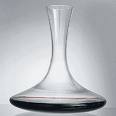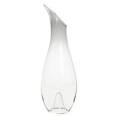Through the holidays and up until Valentine’s Day, I had numerous occasions to reach into the wine cellar for something special. When I did I usually fetched a decanter as well, as much for the aesthetics as anything else.
There is no question that decanting a bottle of wine at the dining table contributes to the ambiance of a special occasion. The wonder is that we don’t do it more often, when we could turn an ordinary Monday night with leftovers into a memorable evening simply by treating an everyday wine as though it were special.
 Better still is the fact that decanting isn’t only for show. Most wines, even white wines, benefit from aeration. Have you ever noticed, for example, that the second half of a bottle of wine usually tastes better than the first half?
Better still is the fact that decanting isn’t only for show. Most wines, even white wines, benefit from aeration. Have you ever noticed, for example, that the second half of a bottle of wine usually tastes better than the first half?
That’s because the exposure to air has softened the tannins, and the wine’s more delicate aromas have had time to flourish. This is true whether you’ve opened a $75 Barolo or a $12 Malbec. Decanting enhances the process of aeration, thus delivering more immediate results and greater pleasure from the entirety of a bottle of wine.
The size and shape of the decanter hardly matters if the alternative is no aeartion at all. But I have a few preferences in my growing collection of wine vessels, and choose the size and shape that fits the wine in intend to decant.
For example, I own a number of decnaters that are flared at the bottom; what the Italians call an onion shape. This type of decanter is perfect for young wines or tannic wines, such as Bordeaux or Barolo. The flare provides a wider surface area than more vertical decanters, giving those gripping tannins more air to make them less astringent.
If I am serving an older wine – and what you might consider old may vary with the type of wine – I prefer a more vertical decanter with less surface area. Older wines lose their primary fruit aromas over time, and what’s left of the fruit after a wine has reached 15, 20, 25 years of age is often fragile.
 A vertical decanter will better preserve the fruit than a flared decanter with a large surface area. If you cared to run an experient – possibly a very expensive and painful experiment – you could use a flared decanter to aerate a 25-year-old Bordeaux or Napa Valley Cabernet. In all likelihood the wine, if from a top producer, would taste fresh and vibrant immediately after decanting.
A vertical decanter will better preserve the fruit than a flared decanter with a large surface area. If you cared to run an experient – possibly a very expensive and painful experiment – you could use a flared decanter to aerate a 25-year-old Bordeaux or Napa Valley Cabernet. In all likelihood the wine, if from a top producer, would taste fresh and vibrant immediately after decanting.
But the wine would eventually fall apart, with the fruit dying in the decanter as the evening passed – exactly the opposite of what happens with a young wine exposed to air over time.
I also have a special decanter for white wines, though generally speaking almost any decanter serves the purposes of getting air to the wine and bringing up flavors and aromas more quickly than they might otherwise evolve. My special white wine decanter has a deep punt that allows for a glass of ice that will keep whites cool for up to an hour or so.
I only use this decanter in warm weather, when I’m afraid my whites will warm too quickly and go dull.
You can spend a small fortune on a decanter, particularly if you fancy crystal from the likes of Waterford or Baccarat. Or you can waltz into any Target and buy something cheap made from regular glass. Cheap works every bit as well as expensive.
And that, like the wine itself, comes down to a matter of taste and budget.
8
